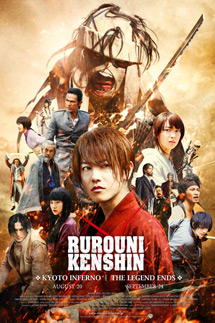 Rurouni Kenshin: Kyoto Inferno sets itself up for a tougher challenge than the one faced by the first movie. The prior installment benefitted somewhat from an easier introductory structure. This sequel tackles a much longer, more complicated story arc: one that spanned nearly a hundred chapters in the original manga, and a full season’s worth of episodes in the TV adaptation. Even when split over the course of two movies, this narrative clearly puts on a strain on the structure of the storytelling. Given that, however, Kyoto Inferno manages to overcome these challenges with a pretty simple approach: lots and lots of amazing action.
Rurouni Kenshin: Kyoto Inferno sets itself up for a tougher challenge than the one faced by the first movie. The prior installment benefitted somewhat from an easier introductory structure. This sequel tackles a much longer, more complicated story arc: one that spanned nearly a hundred chapters in the original manga, and a full season’s worth of episodes in the TV adaptation. Even when split over the course of two movies, this narrative clearly puts on a strain on the structure of the storytelling. Given that, however, Kyoto Inferno manages to overcome these challenges with a pretty simple approach: lots and lots of amazing action.
Former-assassin-turned-pacifist Kenshin Himura (Takeru Satoh) continues to live peacefully at the Kamiya Kasshin dojo. But one day, officials from the new Meiji government ask him to take up the sword again to help defeat another former assassin. Makoto Shishio (Tatsuya Fujiwara), who was once betrayed by the people running the government, has raised an army and is threatening to destroy the entire nation. Kenshin is reluctant to go, but when Shishio’s men kill an old friend, he is forced to make the dangerous trek towards Kyoto and rediscover his violent past.
There is a lot of ground to cover, and at times the film really struggles to make it work on screen. The first arc is particularly dire, the movie simply unable to make its wide swaths of exposition seem interesting. The film, which in other parts seems willing to forego overexplaining things to the viewer, spends much of the first act doing just that, setting up a conflict that doesn’t really need all that much set up. But once the film actually gets going, it thankfully refuses to stop.
After this first act, the film covers three full story arcs in rapid succession. It is weirdly structured as a result, the movie feeling pretty episodic. It shouldn’t really work, but it does, mostly because the action is so much fun to watch. The film cuts each of these stories down to their most basic elements, and lets the fighting take center stage. If there is one thing that director Keiishi Ohtomo is good at, it’s staging samurai fight scenes. There are clunky bits of direction here and there, but when swords are clashing, the movie soars. If anything, it’s gotten better since the last film. Ohtomo stages sequences with ridiculous speed and scale while somehow managing to maintain a sense of internal logic. The big Kyoto sequence is a master class in how to craft intense, chaotic action without sacrificing the storytelling.
Takeru Satoh remains compelling in the lead role. Satoh really captures the conflict at the heart of the character, the occasional burst of rage really highlighting the darkness that’s hidden behind the placid exterior. With a lot of new characters in play, a lot of the new actors have trouble finding their footing. But even then, Tao Tsuchiya as the ninja Misao is a very welcome presence. And Min Tanaka as the elderly-but-still-formidable Kashiwazaki Nenji is a real treat.
As a middle chapter, Rurouni Kenshin: Kyoto Inferno still isn’t what most would consider a truly satisfying experience. This is a really long story they’re telling, and the climax is yet to come. This film is burdened with an anticlimax, with all the good stuff reserved for the next installment. Still, for what it is, the movie pulls off some astonishing things. When it isn’t stuck delivering exposition, it soars with unique, often amazing action sequences that wrangle chaos into an endlessly watchable form.
My Rating:











